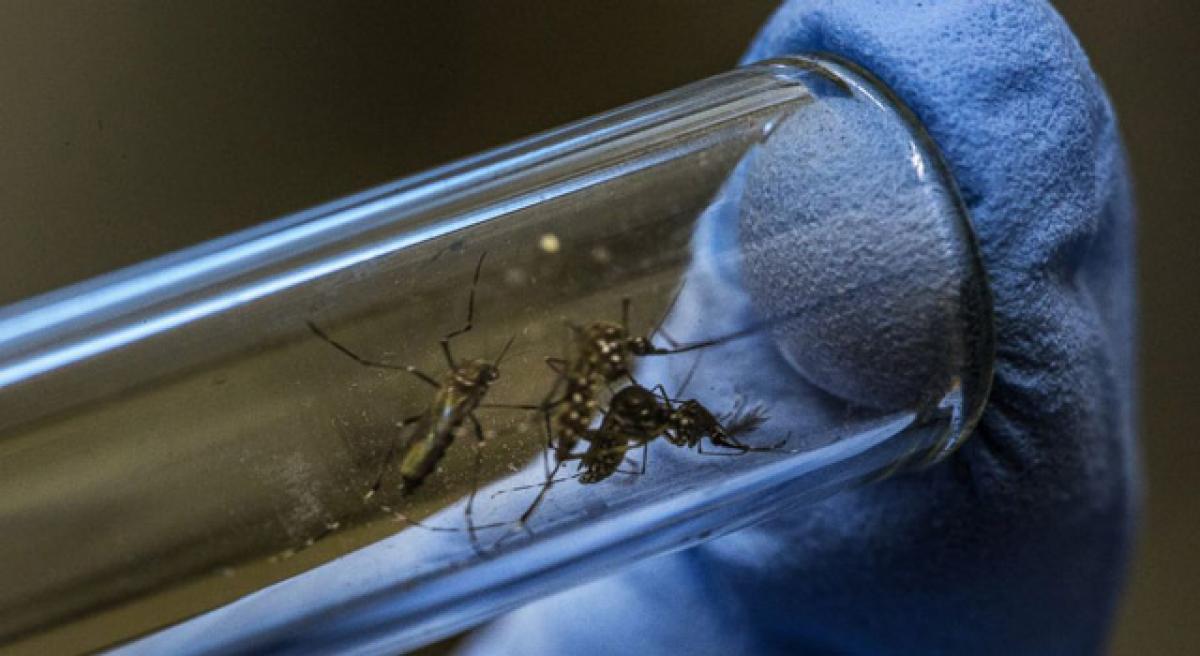Live
- Govt open to discuss all issues, says Kiren Rijiju on eve of Winter Session of Parliament
- Pakistan reports three new polio cases, 2024 tally reaches 55
- Multifold Increase in migratory bird population at TN bird sanctuary
- Archaka Maha Sabha in Jogulamba Gadwal District Highlights Key Demands for Priests' Welfare
- IPL 2025 Auction: Both Rahul and Starc are world-class players, says Delhi Capitals head coach Badani
- Committed to the Welfare of Brahmins - MLA Kuchukulla Rajesh Reddy
- MLA Shri Ganesh Participates in Maha Sudarshana Homam and Srinivasa Kalyanam in Secunderabad
- Terror hideout busted in J&K's Kupwara district
- PM Modi to throw open global cooperative conference on Monday
- Toyota Kirloskar Motor Celebrates “Namma Kannada Habba 2024” Japanese CEO Wins Hearts with Fluent Kannada
Just In
Bacteria in mosquitoes that prevent transmission of dengue fever


A new study from Indiana University may explain how a bacterium called Wolbachia prevents mosquitoes from transmitting deadly diseases such as dengue fever, West Nile virus and Zika.
A new study from Indiana University may explain how a bacterium called Wolbachia prevents mosquitoes from transmitting deadly diseases such as dengue fever, West Nile virus and Zika.
Published today in the journal PLOS Pathogens, the study is one of the first to identify a specific biological mechanism that prevents mosquitoes infected with this bacterium from transmitting diseases to humans.
It could also potentially open a path toward methods to block disease transmission without Wolbachia, an organism whose long-term effect on the environment is unknown.
"There's a real argument that some parts of the world are so strongly affected by these diseases that we need to try everything we can right away," said Irene Garcia Newton, assistant professor in the IU Bloomington College of Arts and Sciences' Department of Biology, who led the study.
"But you've also got to remember that we're releasing insects into the wild that could potentially spread all over the planet very quickly, so it's important to move cautiously."
The use of Wolbachia-infected mosquitoes to curtail the spread of human diseases a method called "pathogen blocking" has already been implemented in some parts of the world. This includes the recent release of these mosquitoes in Florida to block the spread of Zika.
The spread of other insect-borne diseases is also expected to rise significantly in North America over the next several decades due to environmental change, according to the Centers for Disease Control and Prevention.
Other viruses whose transmission is blocked in Wolbachia-infected mosquitoes include chikungunya, yellow fever and West Nile.
To explore the biological mechanisms behind pathogen blocking, Newton and colleagues designed a model system consisting of Wolbachia-infected fruit flies and the Sindbis virus, which is easier and safer to manipulate in the lab than infectious agents such as the Zika or West Nile viruses.
"We've got a lot of genetic tools for Sindbis virus and fruit flies," said Richard Hardy, professor in the IU Bloomington Department of Biology, who is a co-author on the study.
"This means we're able to label different parts of the virus genome and track replication of its RNA inside the host insect." Based upon a comparison of Wolbachia-infected versus uninfected fruit flies, the scientists found that flies with the bacterium produced significantly higher levels of Mt2, a gene that encodes a type of enzyme known as a methyltransferase.
They then used genetic tools to create two types of fruit flies: one that lacked this enzyme and another that produced unusually high levels of it.
The flies without the enzyme lost their ability to "block" the transmission of the Sindbis virus after infection with Wolbachia. The flies that produced high levels of the enzyme were resistant to the Sindbis virus -- even if they weren't infected withWolbachia.
The fact that flies with high expression levels of this enzyme were protected against virus infection despite the absence ofWolbachia is very significant," said Tamanash Bhattacharya, an IU Ph.D. student who is first author on the study.
"These results suggest that the methyltransferase Mt2 alone is sufficient to create a virus protection effect." Moreover, this protective effect likely applies to the transmission of other deadlier viruses, not only the Sindbis virus.
The lack of genetic similarities between viruses blocked by Wolbachia suggests that the bacterium blocks viruses through effects on the host. There are a number of reasons scientists are interested in pursuing methods of pathogen-blocking without Wolbachia, Newton added.
The widespread release of Wolbachia-infected mosquitoes could potentially trigger the rise of viruses resistant to the bacteria, for example. There is also a lack of large-scale epidemiological studies to scientifically determine whether pathogen-blocking actually prevents outbreaks.
"Right now, we know only that mosquitoes infected by Wolbachia don't transmit diseases -- but we don't really know how," Newton said. "If we don't understand the biological mechanisms behind pathogen blocking, we can't really know what will happen over the long term when we release these mosquitoes."
This study was supported in part by the National Institutes of Health's National Institute of Allergy and Infectious Diseases.

© 2024 Hyderabad Media House Limited/The Hans India. All rights reserved. Powered by hocalwire.com






